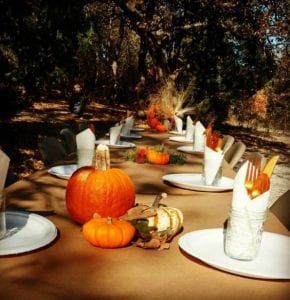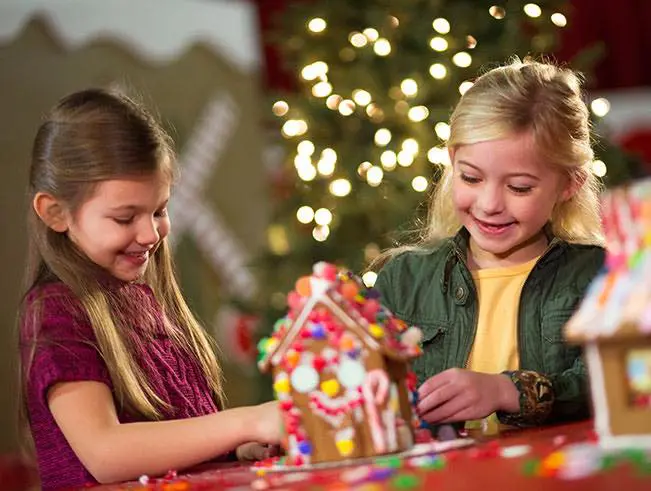Physically Distanced but Socially Connected Holidays
By Nicole M. Young, MSW
I love fall and winter holidays. I look forward to celebrating with lots of food, decorations, gatherings with friends and family, and other traditions. But holiday celebrations in any given year can be hard. It’s a challenging and overwhelming time for many families, especially if money is tight or stress and family conflict overshadow the spirit of joy and giving. In 2020, the holiday season will certainly be different because of COVID-19, but we can still find ways to be physically distanced while staying socially connected with friends and family.
This monthly column provides tips for raising children, based on the world-renowned Triple P – Positive Parenting Program, available to families in Santa Cruz County. If you have a question or idea for a future column, please email me at triplep@first5scc.org.
Dear Nicole,
Do you have tips for handling family gatherings during the holidays? My partner comes from a big family that celebrates major holidays together. His siblings are tired of social distancing and think the family should get together like usual because “it’s tradition.” Our kids adore their cousins and will be disappointed if we don’t see them at all during the holidays, but I worry about being around so many people. I don’t want to fight with my partner, but I also don’t want to spend the holidays worrying about—or getting—COIVD. What should I do?
Tony
Dear Tony,
Thanks for your question! Holiday celebrations will need to be different this year to prevent the spread of COVID-19. As the weather gets colder and (hopefully) rainier this winter, it might not even be possible or enjoyable to hold outdoor celebrations. So this is a good time to develop a plan for safe, healthy holiday celebrations.
 Here are some tips to try:
Here are some tips to try:
Talk with your partner about your hopes and worries about the holidays. Find a time when you’re not tired or rushed so you’re both able to stay calm and present. Start the conversation by saying that you don’t expect to agree on everything but are hoping you can listen to each other and agree on a holiday plan you can both live with. Take turns describing your hopes for celebrating holidays during the pandemic and any worries or concerns about the family’s health and safety. Focus on listening to and understanding each other’s point of view before responding, and avoid criticizing or dismissing each other’s hopes and worries.
Treat public health guidance as “a neutral third person” in your discussion. Check state and local public health rules and guidance for holiday gatherings and travel, and look at the COVID-19 trends in the communities where you and your family members live. This can help you and your partner make an informed decision about whether a modified, safe family gathering is possible, or if holiday gatherings are too risky, particularly for family members who are at higher risk for severe illness if they get COVID-19.
Be flexible and consider low-risk holiday activities. Although many families start making holiday plans months in advance, that will be tricky this year. COVID-19 cases could rise again, so plans that are made even a few weeks in advance might need to change in response to heightened health and safety concerns. If the uncertainty about COVID makes holiday planning too stressful, consider choosing low-risk activities that your family will do, no matter what. This is the safest option that will allow you to enjoy the holidays while minimizing the risk for getting sick and missing out on work, school, family time, or other holiday celebrations.
Examples of low-risk holiday activities include:
- A holiday meal with only the people who live in your household.
- A virtual holiday celebration with extended family and/or friends. Make it fun by sharing recipes, playing games, or giving family members different tasks like creating a music playlist or planning a virtual scavenger hunt.
- A drive-by, no-contact visit with family members who live nearby.
Watching sports events, parades, and movies from home instead of in the community. - A neighborhood “parade” where families display festive signs, decorations, or other holiday items in their windows or yards, then walk or bike (maintaining physical distance) through the neighborhood to admire each other’s displays.
Final Thoughts
The public health guidelines to maintain physical distance, wear masks, and limit nonessential travel are likely to be our reality for a while, but we can still find ways to safely enjoy the holidays—and even discover new ways to celebrate that become family traditions for years to come.
Nicole Young is the mother of two children, ages 17 and 20, who also manages Santa Cruz County’s Triple P – Positive Parenting Program, the world’s leading positive parenting program. Scientifically proven, Triple P is made available locally by First 5 Santa Cruz County, the Santa Cruz County Health Services Agency (Mental Health Services Act) and the Santa Cruz County Human Services Department. To find a Triple P parenting class or practitioner, visit triplep.first5scc.org or facebook.com/triplepscc or contact First 5 Santa Cruz County at 465-2217 or triplep@first5scc.org.
CDC Thanksgiving Recommendations
Lower risk activities
- Having a small dinner with only people who live in your household
- Preparing traditional family recipes for family and neighbors, especially those at higher risk of severe illness from COVID-19, and delivering them in a way that doesn’t involve contact with others
- Having a virtual dinner and sharing recipes with friends and family
- Shopping online rather than in person on the day after Thanksgiving or the next Monday
- Watching sports events, parades, and movies from home
Moderate risk activities
- Having a small outdoor dinner with family and friends who live in your community
- Lower your risk by following CDC’s recommendations on hosting gatherings or cook-outs.
- Visiting pumpkin patches or orchards where people use hand sanitizer before touching pumpkins or picking apples, wearing masks is encouraged or enforced, and people are able to maintain social distancing
- Attending a small outdoor sports events with safety precautions in place
Higher risk activities
- Avoid these higher risk activities to help prevent the spread of the virus that causes COVID-19:
- Going shopping in crowded stores just before, on, or after Thanksgiving
- Participating or being a spectator at a crowded race
- Attending crowded parades
- Using alcohol or drugs, which can cloud judgement and increase risky behaviors
Attending large indoor gatherings with people from outside of your household





